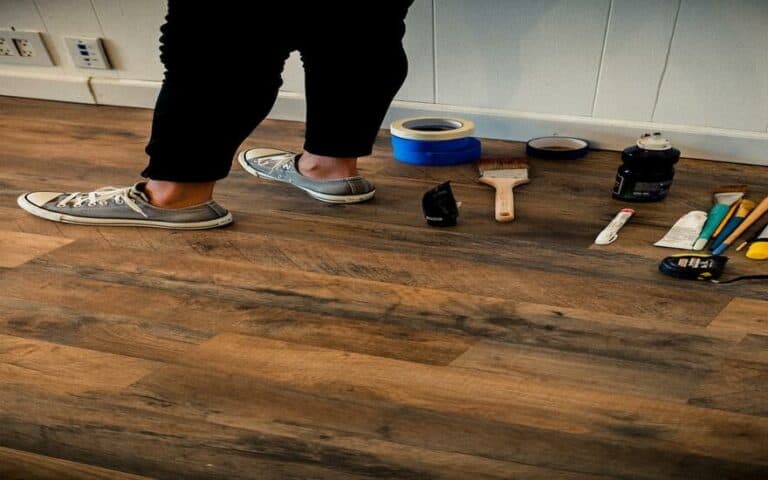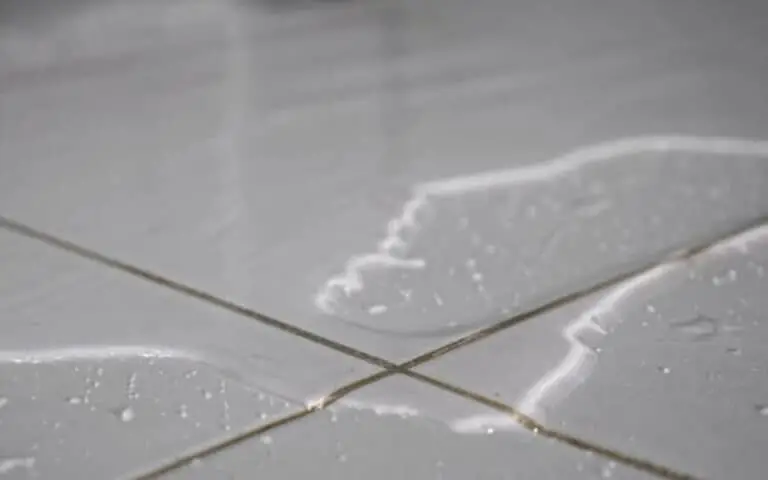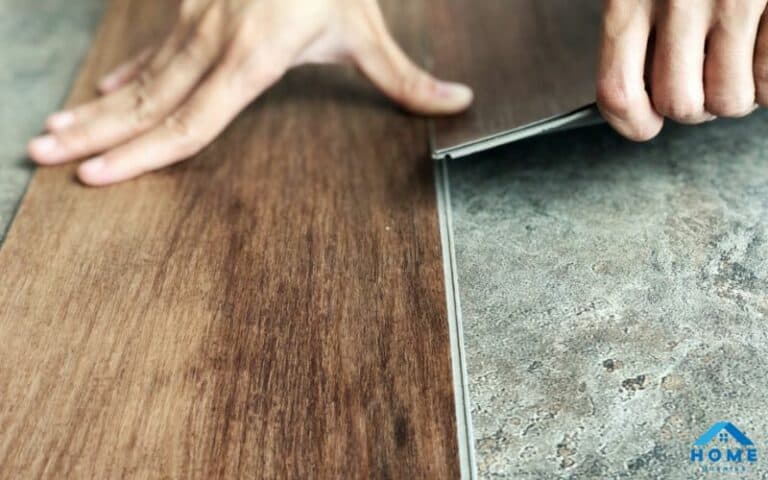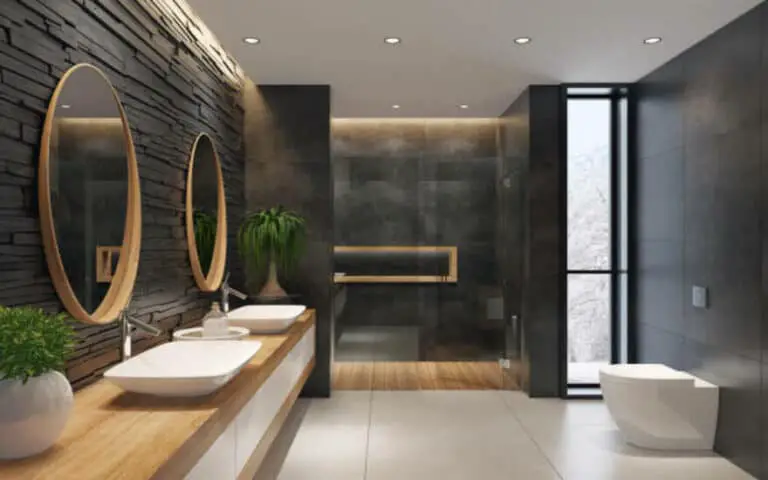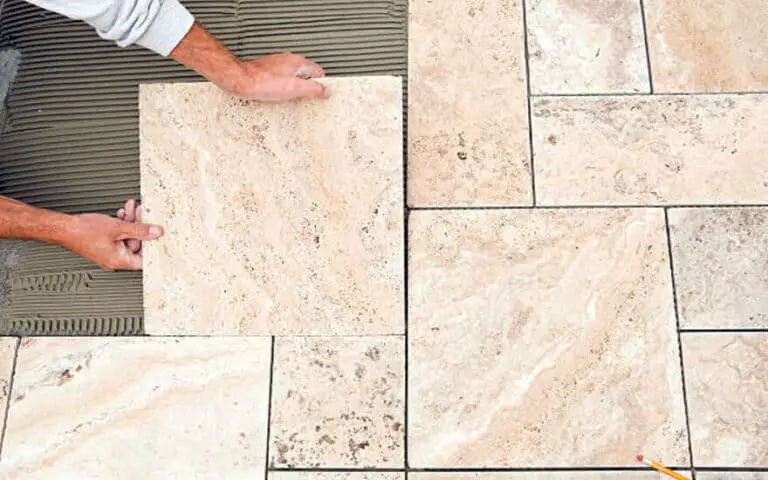Don’t panic! In this blog post, I will discuss the signs of water damage to look out for and how to dry out wet vinyl plank flooring. I’ll also provide some tips on preventing future water damage so you can keep your floors looking great!
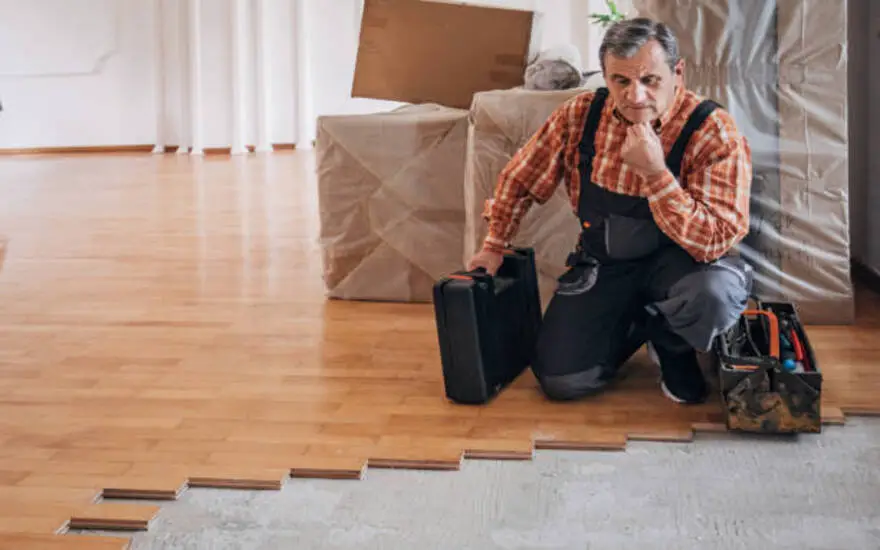
Water under Vinyl Plank Flooring (4 Signs & 4 Dry Tips)
One of the most common problems with vinyl plank flooring is water damage. It’s essential to be aware of the signs of moisture under your flooring and take steps to dry it out as soon as possible. Four signs can indicate water damage: swelling, cupping, discoloration, and odors.
To get rid of the moisture, use a wet vacuum to remove excess water, fans, and dehumidifiers to speed up drying, use a moisture meter to check for moisture levels, and seek professional help if necessary. With the right tools, you can protect your flooring from water damage and prevent further damage.
Signs of Water Damage Under Vinyl Plank Flooring
Water damage on vinyl plank flooring can be easily identified by signs such as swelling, cupping, discoloration, and odor. Swelling occurs when the planks absorb too much moisture, which causes them to expand, and buckling may occur.
Cupping is a sign of excess moisture as it causes the planks’ edges to curl away from the floor. Discoloration can occur due to water damage, causing the vinyl’s color to fade or change. An unpleasant odor may also be present due to mold and mildew growth from excessive moisture.
It is essential to identify these signs early to prevent further damage and take appropriate action. Using a wet vacuum, fans, dehumidifiers, and a moisture meter, we can effectively dry out any water seeped under the vinyl planks and prevent further water damage.
It is advisable to seek professional help for any serious issues related to water damage on your vinyl plank flooring.
1. Swelling
If your vinyl plank flooring starts to swell in the middle, this is a sign of moisture that has gotten underneath. Swelling is usually one of the first signs of water damage, so it’s essential to take action immediately to prevent the damage from worsening.
To help reduce swelling and restore your flooring, you can use a wet vacuum to remove any excess water and then use fans and dehumidifiers to speed up the drying process.
Additionally, you can use a moisture meter to check for moisture levels and, if necessary, seek professional help to ensure your floors are correctly restored.
2. Cupping
Another sign of water damage under vinyl plank flooring is cupping. This is when the edges of the planks are higher than the middle, causing the boards to curl up. This is usually caused by moisture absorbed by the panels or a water leak.
You should remove the baseboard trims and affected boards using a floor scraper to fix this issue. After this, you can use a wet/dry vacuum to remove excess water, fans, and dehumidifiers to speed up drying.
Additionally, you should use a moisture meter to check for moisture levels and seek professional help if necessary.
3. Discoloration
When it comes to discoloration, it’s essential to watch for any changes in the color of your vinyl plank flooring.
This could indicate that water has gotten underneath the floor and is causing damage. If you notice any discoloration, you should take action immediately to avoid further damage.
You can use a wet/dry shop vac and dehumidifier to clean and dry the affected area or seek professional help. In either case, it’s essential to act quickly to prevent further damage from occurring.
4. Odor
When water gets under your vinyl plank flooring, it can cause a musty odor that is difficult to ignore. This is because the water will create an ideal environment for mold and mildew to grow.
If you notice a musty smell, taking action immediately is essential. If left untreated, the odor can worsen and spread throughout your home. To eliminate the odor, you’ll need to address the source of the water and then dry the area thoroughly.
Use a wet vacuum to remove any standing water, then use fans and dehumidifiers to help speed up the drying process. If the smell persists, it’s essential to use a moisture meter to check for any excess moisture that may still be present in the area.
You may need professional help eliminating lingering odors under your vinyl plank flooring if everything fails.
Dry Tips for Water Under Vinyl Plank Flooring
If you discover water underneath your vinyl plank flooring, there are several things you can do to try and dry it. First, use a wet/dry vacuum to remove as much water as possible. This will help to prevent further damage and reduce the time it takes to dry the area. You can also use fans and dehumidifiers to speed up the drying process. Remember to use a moisture meter to check for moisture levels and ensure that everything is dehydrated before reinstalling the vinyl plank flooring. If the job is too much for you, contact a professional to help ensure the job is done correctly and with minimal damage.
1. Use a Wet Vacuum to Remove Excess Water
One of the best ways to remove excess water from under your vinyl plank flooring is to use a wet/dry vacuum. This will help suck up any standing water and any moisture that may have accumulated in the space between the floorboards.
This is a crucial step if you are dealing with an area that has experienced significant flooding. The vacuum will help to quickly remove any water and reduce the chances of further damage due to water accumulation. Be sure to empty the vacuum often and dispose of the water properly!
2. Use Fans and Dehumidifiers to Speed Up Drying
Using fans and dehumidifiers can be a great way to speed up the drying process of water under vinyl plank flooring.
Using a wet/dry shop vac and dehumidifier to gently clean any affected area before using fans and dehumidifiers is essential. This will help dry the room quickly and prevent further damage. Fans and dehumidifiers are instrumental in flooded areas as they effectively remove excess moisture from the air.
Check the moisture levels with a moisture meter before reinstalling vinyl planks, as this will ensure that all of the water has been removed and that the subfloor is completely dry.
3. Use a Moisture Meter to Check for Moisture Levels
A moisture meter to check for moisture levels is essential for anyone dealing with water under vinyl plank flooring.
This device can help determine the extent of the damage and is the most accurate way to measure moisture levels in materials like wood, concrete, and vinyl plank flooring. It’s essential to remember that even if you have removed the excess water from vinyl plank flooring, there may still be residual moisture in the subfloor below.
A moisture meter can help detect this unseen moisture and allow you to take action before it causes further damage. If the readings exceed 5%, seeking professional help immediately is best.
4. Seek Professional Help if Necessary
If you’ve gone through all the steps to prevent water damage on your vinyl plank flooring and still find yourself dealing with excess moisture, it might be time to seek professional help.
A professional can come in and assess the situation, determine the underlying cause of the problem, and provide solutions that can help you restore your floor to its previous condition.
They may suggest installing a vapor barrier or sump pump to reduce the water under your floor, or they may recommend other measures, such as a dehumidifier, to help dry out the area.
With their expertise and experience, you can trust that they will provide a long-term solution for your water issues so that you can feel confident in your floor again.
Are Laminate Floors Water Resistant?
I previously discussed the water resistance of vinyl plank flooring, but what about laminate floors? The good news is that laminate flooring is pretty water-resistant as long as it has been properly installed.
Water can still damage laminate flooring if exposed to excessive amounts of moisture, so it is essential to take steps to prevent water damage. For instance, some laminate flooring products have a wax coating which helps create an additional layer of protection.
Additionally, sealants can be applied to the surface of the laminate flooring to help repel water. Lastly, cleaning up spills quickly and mopping regularly with a damp mop is essential. With these precautions in place, you should be able to keep your laminate flooring looking great for years to come!
How to prevent water damage on Laminate Flooring?
Ensure the subfloor is dry before installing the planks to prevent water damage on laminate flooring.
Use a dehumidifier and moisture meter to ensure the subfloor is dry before laying down the planks. If there is flooding, remove the planks immediately and wipe down the subfloor with a dry cloth. Use a wet/dry vacuum or shop vac to extract any remaining water from the subfloor.
Additionally, if laminate flooring and water come into contact, act quickly to avoid permanent damage. Watch for any signs of water damage, such as swelling, cupping, discoloration, and odor.
If you notice any of these signs, use fans and dehumidifiers to speed up drying, and consider seeking professional help if necessary. Preventative steps can help ensure your laminate flooring stays safe from water damage.
Summary
In conclusion, water under vinyl plank flooring is a serious problem that can cause significant damage to the floor. It’s essential to be aware of the signs of water damage and take steps to dry out the area as soon as possible.
The four signs of water damage are swelling, cupping, discoloration, and odors. The four tips for drying out water under vinyl plank flooring are using a wet vacuum, fans and dehumidifiers, a moisture meter, and seeking professional help.
Additionally, laminate floors are not entirely waterproof, but there are steps you can take to prevent water damage on laminate flooring. Taking the steps outlined in this blog will ensure that your vinyl plank flooring remains in good condition for years.

